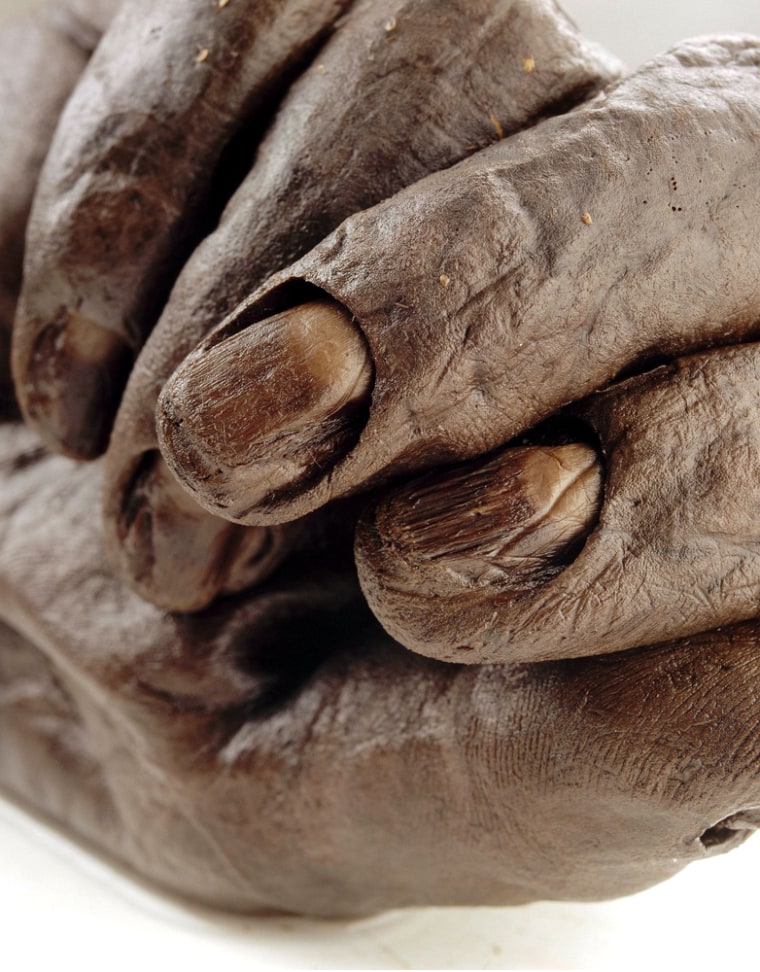Life in the Iron Age may have been nasty, brutish and short, but people still found time to style their hair and polish their fingernails — and that was just the men.
These are the findings of scientists who have been examining the latest preserved prehistoric bodies to emerge from Ireland’s peat bogs, the first to be found in Europe for 20 years.
One of the bodies, churned up by a peat-cutting machine at Clonycavan near Dublin in 2003, had raised Mohawk-style hair, held in place with gel imported from abroad.
The other, unearthed three months later and 25 miles (40 kilometers) away in Oldcroghan by workers digging a ditch, had perfectly manicured fingernails.
“I think the message I’m getting is that although they were living in a different time, a different culture, eating different things, living in a different way, people are people — they’re the same in their thinking,” said Rolly Read, head of conservation at the National Museum of Ireland in Dublin.
Read is one of a team of experts from Britain and Ireland who carried out an 18-month examination of the 2,300-year-old corpses and whose findings form the basis of “Kingship & Sacrifice,” a major new exhibition at the museum.
Iron Age life
While the last two centuries have seen hundreds of bog bodies recovered from northern Europe’s wetlands — where they were preserved by the unique chemical composition of the peat — many were not examined in detail because techniques to further preserve them had not been perfected.
Read said the latest finds had yielded precious insights into Iron Age life.
For example, the hair product used by Clonycavan Man was a gel made of plant oil and pine resin imported from southwestern France or Spain, showing that trade between Ireland and southern Europe was taking place almost two and a half millennia ago.
“We’ve been able to apply techniques that weren’t available back in 1984, so it’s a chance to actually look at aspects of Iron Age people that haven’t been explored before,” Read said.
Why the bogs?
Archaeologists have always puzzled over why the bodies ended up in peat bogs and why so many of them show signs of violent death, with much debate about whether they were executed for crimes or ritually slain as human sacrifices.
Both Clonycavan Man and Oldcroghan Man — who were in their 20s when they died — met grisly ends, the latter in particular bearing the scars of horrific torture, including having his nipples cut almost through.
Like several other bog bodies, Oldcroghan Man had been beheaded. Other examples, such as Denmark’s famous Tollund Man, discovered in 1950, still had the rope used to strangle them around their necks.
Manicured fingernails and evidence of good diet — not to mention Clonycavan Man’s taste for imported cosmetics — seem to indicate that many of those who ended up in the bogs were from the upper classes.
Appeasing the gods?
Eamonn Kelly, keeper of Irish antiquities at the National Museum of Ireland, has developed a new theory about the bodies based on his discovery that nearly all of the Irish examples were placed in the borders immediately surrounding royal land or on tribal boundaries.
“These people may have been hostages or deposed kings or candidates for kingship who have been sacrificed to ensure a successful reign for a new king, and this was done as part of a kingship ritual and as a fertility offering to the gods,” he told Reuters.
“The king was held personally responsible for the success of the crops and so on — if he couldn’t guarantee the fertility of the land, he risked being deposed,” he added.
Another theory, prompted by the writings of Roman historian Tacitus from around the same era, is that the perpetrators of “shameful crimes” were put into the bog in order to trap their souls in a watery limbo where the body did not rot.
The "Kingship & Sacrifice" exhibition includes Iron Age artifacts such as weapons, feasting utensils, boundary markings and kingly regalia — all of which are often tied in with bog burials in a number of locations, according to Kelly.
The two most recent bodies — tanned to a mahogany sheen by acids in the bog water — have now been freeze-dried for long-term preservation and have found their final resting place under glass in Ireland’s national museum.
